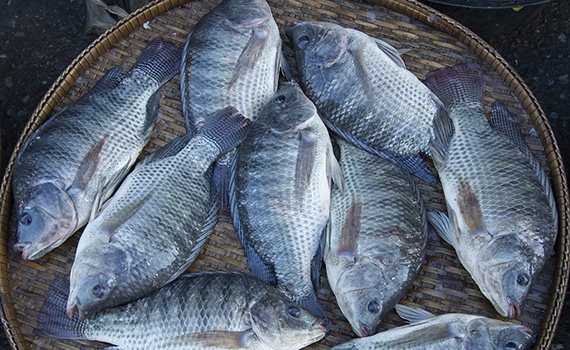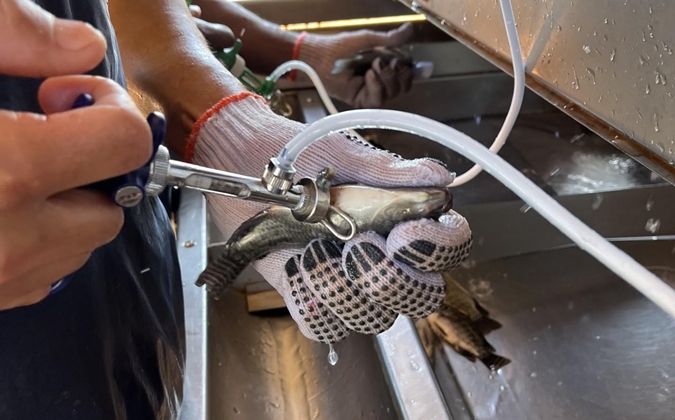
Vaccine ‘work in progress’ in major aquaculture markets, Part 2: Tilapia
The scientific journal Vaccines recently published a review of “the most significant and innovative vaccine research” in three economically important fish species: European sea bass, Nile tilapia and Atlantic salmon. In this three-part series, the editors of Fish Health Forum summarize the main findings for each species.
Nile tilapia is now the second most farmed fish worldwide, in part due to its adaptability. It is, however, susceptible to a number of diseases.
Most vaccine research to date has focused on bacterial pathogens, with a considerable diversity of formulation approaches and species targeted – though the Streptococcus genus, and particularly S. iniae, features heavily in developments cited in the review.
Tackling key cause of tilapia disease
“Attenuated vaccines against Streptococcus iniae appear to be highly immunogenic,” the authors said, citing research showing 100% and 79 to 100% relative percent survival (RPS) after intraperitoneal (IP) vaccination against parental and heterologous strains of the pathogen, which causes high mortality and morbidity rates. An RPS of 86% was also observed using bath administration.
One research group focused on vaccination against S. iniae using formalin-killed cells in a broth with extracellular products, the authors explained. Using IP administration, RPSs of 79-100% were observed against four heterologous strains. Previous work by the same researchers had used inactivated vaccine delivered by IP injection and oral treatment. The oral route reduced mortality compared to controls, but not to the levels achieved by injection.
“The study preliminarily demonstrated that oral vaccination, although less efficacious than the IP route, could indeed confer some degree of protection to tilapia,” the scientists commented.
A recent development in work to combat S. iniae was the design of a DNA vaccine, they continued, with results “demonstrating the involvement of both innate and adaptive immune response.”
Low-cost polyvalent vaccine shows promise
A low-cost polyvalent vaccine of inactivated S. iniae, S. agalactiae, Lactococcus garvieae, and Enterococcus fecalis in combination with an adjuvant may provide the double advantage of stimulating the immune response of tilapia larvae but also increasing broodstock reproductive performance, the authors explained. This may make the work of particular relevance to developing countries.
“Further studies should investigate larval production and survival rates of vaccinated vs. unvaccinated adult specimens to examine the consistency of the present results,” they stressed.
Can the right adjuvants increase efficacy?
Oil-based adjuvants have been used in experimental inactivated vaccines against Francisella orientalis, the causative pathogen of francisellosis, the authors said. In one such study cited in the review, no mortality was observed, whereas adjuvant-only and control groups saw 36% and 63.3% mortality, respectively. Another experiment using larger fish saw 82.3% RPS when challenged with homologous infection, and immune response was only observed in vaccinated fish.
A third study with an oil-based adjuvant used a different F. orientalis strain (AOD104086), the scientists continued, while also testing challenge both by IP injection and immersion. The vaccine formulation was shown to stimulate immune response, protect fish when challenged, and reduce blood bacteria concentration as well as granuloma formation on spleen and kidneys, they said.
“Taken together, these three studies reveal that formalin inactivation may offer satisfactory immunogenicity to vaccines against Francisella orientalis when combined with oil-based adjuvants, with some evidence of protection even against heterologous strains albeit weaker than the homologous one,” the authors explained.
Research hints at commercial potential
Research to date on vaccines against Aeromonas hydrophila, a bacterium which causes haemorrhagic septicaemia in fish, includes both inactivated and attenuated options, they explained. Different inactivation protocols have been explored, with two heat treatments and formalin tested in one study, demonstrating high antibody titers.
Attenuated vaccines created by repeated culturing with the antibiotics novobiocin and rifampicin, using three different strains of the pathogen, proved “highly effective” in another piece of work, explained the researchers, with RPSs of up to 100%. Producing a highly immunogenic strain was achieved by selecting for antibiotic resistance – and the approach shows high potential, the authors suggested.
“Importantly, these vaccines were also tested and found effective on channel catfish, a species for which two commercial vaccines formulated with rifampicin-resistant strategy are available. Soon, commercial vaccines against A. hydrophila outbreaks in tilapia might be developed,” they said.
Work needed to hone approaches
A subunit vaccine against Vibrio anguillarum showed protection against the pathogen in one study cited in the review, but the use of two injections within 14 days provoked a note of caution in the authors.
“The use of two distinct injections at such a short distance in time likely represents a stressful practice for the animal and definitely contributes to increasing the procedure costs. A formulation that contains both the antigen and the adjuvant to be administered in a single injection would be preferable for a field-deployable vaccine,” they said.
There are “two promising vaccine candidates” against Edwardsiella tarda, the researchers explained. One used a recombinant protein, while the other used whole-cell formalin inactivation, with both using an oil-based adjuvant. Tilapia immunized with both formulations saw the lowest cumulative mortality and highest RPS, though the authors suggested that further work might be necessary to achieve a more complete immune response, particularly considering the impact of Edwardsiella sp. outbreaks in Asian, American and European aquaculture.
The road to sea lice vaccination?
One example of research on vaccination against the sea louse Caligus rogercresseyi was reported – but it could prove telling.
Researchers used recombinant protein from the species and an adjuvant to elicit an immune response – with higher titers observed in fish that received a booster, the authors noted. Although the intention was to use tilapia as a model for the knowledge then to be transferred to salmon, the work could provide a new approach to sea lice control more broadly, they said.
“The ultimate application could be the development of a commercial vaccine, which is still not available for any teleost species,” the researchers added.
Early days for antiviral vaccines
The reviewers found only one previous published work on antiviral vaccines in tilapia: the first steps towards a DNA vaccine against tilapia lake virus (TiLV) using a herpes virus vector. Another recent study involved an experimental challenge with TiLV, to understand how disease takes hold of infected fish.
“These data are valuable for understanding the molecular pathways affected and the histopathological progression as well as mortality onset and rates, and could lay the groundwork for future applications,” the researchers explained.
To view the full review in Vaccines, click here.
Posted on: June 09, 2021






